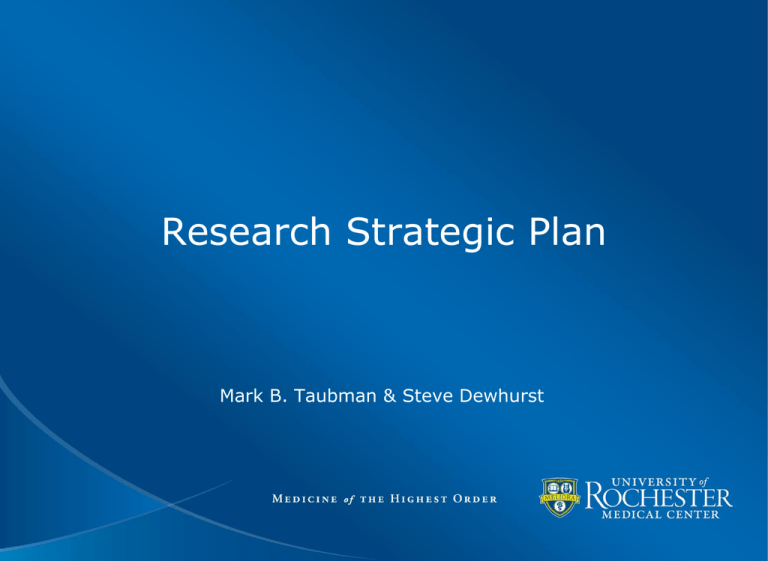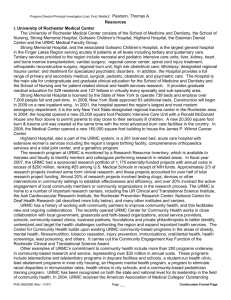Research Programs of Excellence - University of Rochester Medical
advertisement

Research Strategic Plan Mark B. Taubman & Steve Dewhurst Research Enterprise: Then and Now 1996 2007 2013 Total Award Count 658 1,520 1,331 NIH Award Count 253 451 393 Total $'s Awarded $90,857,149 $244,849,174 $199,683,043 NIH $'s Awarded $60,457,715 $161,840,899 $132,414,203 111 537 335 175 824 612 172 816 573 303,512 536,392 643,968 Basic Science Faculty Tenure Track Faculty PI’s on Grants Research Space (ft2) 2 Biomedical Research Environment Strengths: Faculty Size and Breadth Strong Clinical and Translational Research Programs (CTSI) Collaborative Environment; Proximity to River Campus Weaknesses: Few Nationally-Prominent Programs Financial: SMD Structural Deficit, Reliance on SMH Margin, Heavy Reliance on NIH Funding, Tech Transfer Opportunities: Enhance National Reputation by Focusing on Multi-Departmental, MultiDisciplinary Programs of Excellence Threats: NIH Budget Reduced SMH Margin (Health Care Reform, Graduate Medical Education) 3 Research Vision/Mission Mission: To improve the health of the community through research and discovery. Vision: To be nationally recognized for our research programs of excellence. Goal: Create a sustainable research enterprise focused on programs of excellence that feature cutting edge science, have national/international prominence, and the potential for significant scientific/clinical breakthroughs. 4 Research Strategic Plan Promote Research Programs of Excellence Strengthen Key Core Facilities • Biomedical Informatics • Stem Cells • Imaging Promote Translational Research • CTSI Restructuring • Educational Initiatives Provide the Financial Needs of Research/Education • Implement a Sustainable Financial Model • Strengthen New Revenue Sources 5 Strategic Plan: Principles Prioritization of Resources: • Support our current faculty • Focus resources on key institutional needs with synergistic value (e.g., informatics) • Identify and support broadly inclusive scientific Programs of Excellence – will be achieved largely thru pilot funds to support new research Faculty Recruitment: • Will be limited in total #s • Impact will be greatest if hires meet institutional needs (specific skills/technologies/areas)…..which means diverging from the traditional model of simply hiring the best available athlete regardless of “fit” 6 Identify and support research programs of excellence 1. Restructure around multi-departmental research programs of excellence. • Programs (basic, clinical, and translational) either already exist or can be developed through enhanced collaborations and/or key strategic recruitments. • Feature cutting edge science, dovetail when possible with our clinical areas of excellence, and have the ability to attain national/international prominence or to achieve breakthroughs that can impact on the health of our community and/or reduce healthcare costs. 7 Research Programs of Excellence Cancer RNA Biology Infection & Immunity RoAR Institute (Aging Research) Musculoskeletal Lung Biology Cardiovascular Comprehensive Diabetes Center Neuromedicine Vision Restoration • Systems, Cognitive & Computational Drug Targets & Mechanisms • Neuroinflammation & Neurodegen. Childrens’ Research Institute • Neuromuscular Disease • Center 4 Translational Neuromedicine • Autism Research Center Health and Wellness (Prevention) 8 Shared needs: Current initiatives we should continue Areas: • Trainee support. New partnerships such as the UR China Institute. This is a tension in our cost-cutting proposals. • Career development of young and mid-career faculty. • Flexible sabbatical programs. • Interim funding. Has been increased recently. • Shared Resource Labs. • Drug discovery (Drug Discovery Pilot Award program). 9 Shared needs: Needed new initiatives Areas: • Scientific community building: 1. Intellectual communities. Seminar programs, meetings/symposia 2. Physical communities. Realign space. 3. Shared infrastructure and basic equipment. New Small Equipment Award program thru SAC. See: http://www.urmc.rochester.edu/smd/scientific-advisory-committee/ • Pilot funding: Most programs identified a need for 1-2 pilot awards of $50k each, per year. A key philanthropic target. • Private sector partnerships: SBIR/STTR awards. • Philanthropy: All programs need to engage Advancement, to obtain necessary resources (including faculty recruitments). 10 Identify and support research programs of excellence 2. Prioritize support for programs of excellence. • Overall Goal: National/international recognition of five programs. • Scientific Advisory Committee to oversee. • Support based upon resources required, potential for extramural funding, and potential for breakthroughs or national recognition. Proposed investment ≈$2.5 Million/year; ideal is $5M/yr - but acheiving this depends on finances (cost reduction, revenue generation), philanthropy (endowed chairs, program funds), URMC • Pilot/Seed Grants • Equipment, Services • Strategic Recruitment • Yearly milestones and evaluations. 11 Scientific Advisory Committee Charge: Advises on strategic decisions relating to recruitment, academics, infrastructure investments, and space allocations. Members: Faculty conducting fundamental, translational and clinical research, drawn from multiple departments and centers. Programs: • New Pilot Award Program: To support innovative, trans-disciplinary science. $125k/year for up to 2 years • Small Equipment Award Program: To provide partial support ($2- 25k) for small shared equipment (costing $15-$100k). http://www.urmc.rochester.edu/smd/scientific-advisory-committee/ 12 SAC: Members Dewhurst, Steve (Chair) Bennett, Nana (CCH) Bohmann, Dirk (BMG) Dozier, Ann (PHS) Gasiewicz, Tom (EHS) Halterman, Jill (PEDS) Land, Hucky (JPWCC/BMG) Maquat, Lynne (RNA) Moxley, Dick (NEURO/CTSI) Schwarz, Eddie (CMSR) Sime, Tricia (MED) Strawderman, Rob (DBCB) Tank, Bill (P&P) Topham, Dave (CVBI/HSCCI) Reps from Other Schools Eliav, Eli (EIOH) Kitzman, Harriet (SON) Ex Officio Kieburtz, Karl (SADCR/CTSI) Lord, Edith (SADGE) O’Keefe, Regis (AD Clin. Aff) Puzas, Ed (SADBR) 13 Research: Synergy With Revenue Generation Investment in Research Revenues Reinvested Discovery From clinical programs, royalties, equity Innovations, new treatments New Clinical Programs, Reputation Enhancement Draws in New Patients Intellectual Property Generate Royalties, Equity, Sponsored Research Chris DiFrancesco New Revenue Generation (I) Integrated Business Engagement approach: Corporate Relations (Adam Tulgan): Single business POC; leverage alumni in industry; work w. ORPA (-> partnerships, sponsored research, corporate philanthropy) URVentures (Scott Catlin): Enhance technology development (new revenues); facilitate SBIR, STTR awards Center for Entrepreneurship: Create partnerships; provide training in entrepreneurship (defined broadly) Clinical Trials (CTSI): Create a new support function in collaboration with the CTSI; partner with other health systems Center for Medical Technology Innovation (CMTI): Grow! 15 New Center for Business Engagement UR Ventures UR Corporate Relations UR Center for Entrepreneurship UR Center for Business Engagement Rob Clark 16 New Revenue Generation (II) Partnering Initiatives (Selected): Clinical Trials: Other health systems as potential partners Data Science & new Rochester Center for Health Informatics: IBM, Xerox VA hospital linkages: New funding opportunities (career award grants) •Can’t rely on new sources of revenue in the short term. 17 Metrics (will vary with type of program) Measures of national (or international) recognition • National Academy, major prizes, leadership roles, unique grants Discovery metrics • New High impact scientific knowledge Translational metrics • New targets, promising devices or diagnostics, patents, INDs, IDEs Clinical impact metrics • First in humans, practical applications Community benefit metrics • Measurable impact on quality oflLife Policy metrics Productivity metrics 18 Center for Biomedical Informatics (CBI) • Create informatics infrastructure necessary to support clinical, translational & basic research; integrate w. and leverage new UR Data Science Institute • Recruit faculty with independent research (clinical and basic) programs to complement existing faculty. Searches: (1) Cancer genomics (translational); (2) Clinical research informatics; (3) CTSI director of BMI (hired Tim Dye) • Establish the CBI as a vehicle for training scientists and physicians in biomedical informatics. • New MS, PhD programs; future Clinical Informatics fellowship Cost >=$2.5-3 M, to be shared by several divisions of URMC 19 Rochester Institute for Data Science • Predictive Health Analytics: Predict disease/risk; optimize therapy. Examples: Cancer Rx prediction, Chronic heart disease, Infectious disease tracking, Suicide prevention • Cognitive Systems: Model and/or replicate human perception and cognition. Examples: Linguistics, Neural pathways and prosthetics, Vision restoration • Analytics on Demand: Development of intuitive user interfaces to query big data. Creating tools/systems for largescale data analytics that relieve the end-user from the need to understand the details of particular platforms/programs. 20 Overview of UR-Wide Strategic Plan • Rochester Institute for Data Science • Research Foundations for a Healthier Society. Imaging; Drug development & delivery; Molecular signaling; Social & behavioral science; Neuromedicine; Environmental medicine • Light and Sound. Vision & Optics; Institute of Sound (sound in: music and entertainment; medicine & biology; speech, hearing, language & communication) • UR Research in the Local & Global Community: Research translation (CTSI, CMTI, CE); Research partnerships (new Center for Business Engagement); International programs • Rochester Center for Energy & the Environment. Carbonneutral energy; Human health (toxicants); Climate and C-cycle 21 Research Foundations for a Healthier Society •Social and behavioral approaches to improve health. Ex: Health economics & improving healthcare (resource supply/use; ties to PCORI and CMMI); Human motivation & systems change (smoking, weight management); Social analytics (isolation; affect spread) •Imaging. Ex: Brain activity; Cancer Dx; Immune cell trafficking •Drug development and delivery. Ex: RNA as a target or drug; Smart scaffolds for tissue repair; new therapeutic targets •Neuromedicine. Ex: Autism spectrum; Systems, Cognitive & Computational neuroscience; NMD; Neurodegen; Translational •Molecular signaling in relation to cell aging, function. •Environmental medicine and energy policies. Ex: fracking. 22 Initial Priorities (2014) 1. Support existing faculty. Protect existing departmental budgets, most of which go to faculty salaries. 2. Honor existing commitments (open searches). E.g., Cntr for Musculoskeletal Research; Immunity & Infection program 3. Recruit in areas of broad value. CBI (2 ongoing recruits); PHS Chair; other areas may include health economics (resource supply/use; PCORI/CMMI), drug discovery and development 4. Support new programs/collaborations. Fund “program-building” pilot awards in broadly impactful areas – (i) Aging (RoAR), (ii) Prevention, (iii) Stem Cells & Regenerative Medicine (6 pilots, $300k total) 23











